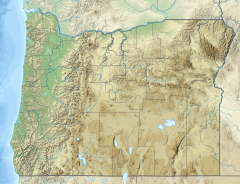Aspen Butte is a steep-sided shield volcano in the Cascade Range of southern Oregon. It is located 15 miles (24 km) south of Pelican Butte and 15 miles (24 km) southeast of Mount McLoughlin. It rises over 4,000 feet (1,200 m) above the nearby shore of Upper Klamath Lake. Ice Age glaciers carved three large cirques into the north and northeast flanks of the mountain removing most of the original summit area including any evidence of a crater. The summit is now the high point along the curving ridge which bounds the southern edge of the cirques above steep cliffs.
| Aspen Butte | |
|---|---|
| Highest point | |
| Elevation | 8,215 ft (2,504 m) NAVD 88[1] |
| Prominence | 3,088 ft (941 m)[2] |
| Coordinates | 42°18′56″N 122°05′15″W / 42.315491489°N 122.087565778°W[1] |
| Geography | |
| Location | Klamath County, Oregon, U.S. |
| Parent range | Cascade Range |
| Topo map | USGS Aspen Lake |
| Geology | |
| Rock age | 4.9-3.5 Ma[3] |
| Mountain type | Shield volcano |
| Volcanic arc | Cascade Volcanic Arc |
| Last eruption | Pleistocene |
| Climbing | |
| Easiest route | Trail |
Aspen Butte is the highest of four overlapping shield volcanoes within the Mountain Lakes Wilderness all of which have been carved to varying degrees by glaciers. The other volcanoes are 7,979-foot (2,432 m) Mount Harriman,[4][5] 7,785-foot (2,373 m) Crater Mountain and 7,741-foot (2,359 m) Greylock Mountain. Another peak, 7,882-foot (2,402 m) Mount Carmine,[6] which lies just over 1 mile (1.6 km) to the north of Aspen Butte, is actually not a separate volcano but the highest remnant of the north flank of the Aspen Butte volcano separated from it by two glacial cirques. Little Aspen Butte, a 7,235-foot (2,205 m) satellite cone, rises on the southern flanks of the main volcano separated from it by a 6,556-foot (1,998 m) pass.
References
edit- ^ a b "Aspen". NGS Data Sheet. National Geodetic Survey, National Oceanic and Atmospheric Administration, United States Department of Commerce. Retrieved 2008-11-02.
- ^ "Aspen Butte, Oregon". peakbagger.com. Retrieved 2021-12-02.
- ^
Smith, James G.; Benham, John R. (1984). Sky Lakes Roadless Area, and Mountain Lakes Wilderness, Oregon. Geological Survey (U.S.). p. 905.
{{cite book}}:|work=ignored (help) - ^ "Mount Harriman, Oregon". peakbagger.com. Retrieved 2021-12-02.
- ^ "Mount Harriman". NGS Data Sheet. National Geodetic Survey, National Oceanic and Atmospheric Administration, United States Department of Commerce. Retrieved 2008-03-31.
- ^ "Mount Carmine, Oregon". peakbagger.com. Retrieved 2021-12-02.
- Sources
- Harris, Stephen L. (2005). Fire Mountains of the West: The Cascade and Mono Lake Volcanoes (3rd ed.). Mountain Press Publishing Company. ISBN 0-87842-511-X.
- Wood, Charles A.; Kienle, Jürgen, eds. (1990). Volcanoes of North America. Cambridge University Press. ISBN 0-521-43811-X.
- Carver, Gary Allen (1972). Glacial Geology of the Mountain Lakes Wilderness and Adjacent Parts of the Cascade Range Oregon. Ph.D. dissertation, University of Washington.
